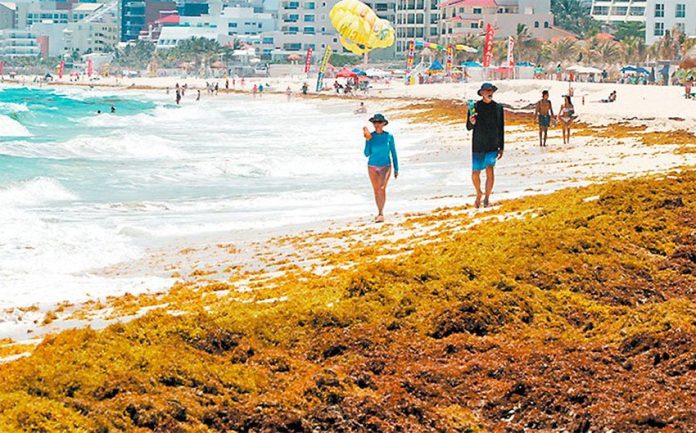Tourism will fall by as much as 30% at Quintana Roo beach destinations this year due to the invasion of sargassum, according to the federal government.
The secretariats of the Environment (Semarnat) and the Interior (Segob) predicted in a joint report that at least 200 kilometers of coastline in the Riviera Maya will be affected by the seaweed.
Cancún, Playa del Carmen, Puerto Morelos, Tulum, Cozumel and Isla Mujeres are all located on the stretch of coast where more than a million tonnes of sargassum could sully the turquoise waters and stain the white-sand beaches.
Cancún and Puerto Morelos Hotels Association president Roberto Cintrón said the downturn in tourism due to sargassum will cost the industry millions of dollars.
“If the problem is not adequately contained the economy of the state and country will be at risk,” he said.
Cintrón contended that the viability of the Maya Train project and the National Tourism Promotion Fund (Fonatur) – which is managing the ambitious Yucatán peninsula rail project – could also be placed at risk if visitor numbers to the state significantly decline.
“Quintana Roo attracts 50% of international tourists who arrive in the country, Fonatur depends on the non-resident tax that international tourists pay. If that’s affected by 50% the Maya Train as well as the fund for international promotion and the National Tourism Promotion Fund will be at risk,” he said.
“The problem will grow to a national scale because if there is a reduction [in funds] for the organization in charge of international promotion, other tourist centers like Los Cabos will be affected, they all need international promotion,” Cintrón added.
In Mahahual, where large quantities of sargassum have begun washing up on the beach, 40% of hotel reservations have been canceled in recent days, according to a Quintana Roo tourism official.
“This is serious. A lot of sargassum has already arrived . . . People who arrive say: ‘I’m not going to the beach, I’m better off going to another place’ and they leave,” Arturo García said.
He added that it was concerning that authorities haven’t yet begun contributing to clean-up efforts, leaving local hoteliers and their employees to remove the seaweed from the beaches themselves.
Armina Wolpert, the Russian consul in Quintana Roo, also said that there are “apparently no concrete actions” from state and federal authorities to combat the arrival of sargassum.
She said that “Russian tourists come only and exclusively for the Mexican Caribbean Sea,” pointing out that they are prepared to put aside security concerns to visit Quintana Roo.
However, Russian media has published images of people swimming amid sargassum and “that generates a negative impact on tourists’ plans,” Wolpert said.
There are currently 11 direct flights between Moscow and Cancún each month but the consul warned that flights will be canceled if demand from tourists drops as a result of the sargassum invasion.
President López Obrador announced earlier this week that the navy will lead efforts to combat the massive arrival of seaweed and said the government’s anti-sargassum plan will be presented next week.
According to a forecast made by a Quintana Roo sargassum council in January, three times as much seaweed will invade the Caribbean coast this year. If the prediction comes true, 1.56 million tonnes of the brown macroalgae will arrive.
Federal, state and municipal authorities spent 332 million pesos (US $17.2 million) between June and December last year to attend to the invasion of sargassum but this year an investment of more than 720.5 million pesos (US $37.6 million) is predicted in the Semarnat/Segob report.
The two secretariats estimated that the arrival of the smelly and unsightly seaweed caused economic damage of just under 5.3 billion pesos (US $275 million) last year. At least 522,226 tonnes of sargassum were removed from the sea and beaches in Quintana Roo, they said.
The report, which was obtained by the newspaper Milenio, revealed that a four-phase plan to tackle the sargassum problem has been developed.
The first 30-million-peso phase involves tracking the movement of the seaweed using radar and satellite images, while the second 420-million-peso phase consists of using boats to remove sargassum from the sea.
A third phase involves removing sargassum from beaches at a cost of just under 235.5 million pesos while the fourth and final 35-million-peso phase consists of monitoring water and air quality at Quintana Roo beaches.
Source: Milenio (sp)
